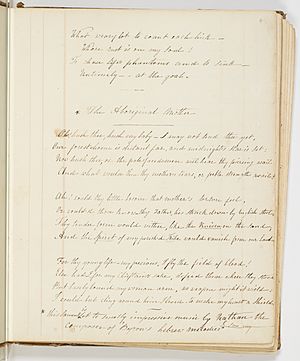Eliza Hamilton Dunlop facts for kids
Quick facts for kids
Eliza Hamilton Dunlop
|
|
|---|---|
| Born | Eliza Hamilton 1796 County Armagh, Ireland |
| Died | 20 June 1880 (aged 83–84) Wollombi, New South Wales |
| Resting place | Church of England cemetery in Wollombi |
| Occupation | Poet, songwriter |
| Nationality | Irish |
| Spouse |
|
Eliza Hamilton Dunlop (1796 – 20 June 1880) was an Irish-Australian poet and songwriter. She is best known for writing the powerful poem "The Aboriginal Mother."
Eliza was born in County Armagh, Ireland. She grew up with her grandmother and a guardian because her father went to India and her mother passed away. Later, Eliza traveled to India herself. There, she found out she had two half-sisters. Eliza started writing poems when she was a child in Ireland. After she moved to Australia, her poems and songs were printed in local newspapers. Some of her songs even had music added by a composer named Isaac Nathan.
Contents
Eliza's Early Life and Family
Eliza Hamilton was born in 1796 in County Armagh, Ireland. Her father, Solomon Hamilton, was a lawyer. He raised her in the Anglican faith, which is a type of Christianity. Eliza's mother died soon after she was born. Her father and two older siblings later moved to Bengal, India. He became a judge there. Because of this, Eliza was raised by her grandmother and then by a guardian. Her father sent her money from India, but it was often hard for her to get it.
First Marriage and India Trip
When Eliza was 16, in 1812, she married her first husband, James Sylvius Law. He was an astronomer, someone who studies stars and planets. They had two children, a daughter named Mary Sophia Georgina, born in 1816, and a son. The family lived in Coleraine, Ireland.
In 1820, Eliza traveled to Kolkata, India, to visit her father. Sadly, she learned that he had died while she was on her journey. She also discovered that her father had two daughters in India, who were her half-sisters. Eliza inherited some money from her father, which helped her financially. After her trip, she returned to Britain.
Second Marriage and Move to Australia
In 1823, Eliza married again to David Dunlop. He was a bookseller from County Antrim, Ireland. They got married in Portpatrick, Scotland. Both Eliza and David were interested in politics, but David never became a politician. They had several children together, but one daughter sadly passed away at age 8.
On 25 February 1838, Eliza, David, and their four children moved to Sydney, Australia. David briefly worked as a magistrate in Penrith, New South Wales. A magistrate is like a local judge. In 1839, he became a police magistrate in the village of Wollombi. He also worked as a protector for Aboriginal people. David built a stone house there and kept these jobs until 1847.
Eliza's Writing Journey
Eliza started writing poems when she was a young girl. While living in Ireland, her poems appeared in local magazines, newspapers, and books. Even during her short visit to India, some of her writings were published in a journal there.
After moving to Australia, Eliza kept writing poems and song lyrics. A famous composer named Isaac Nathan arrived in Sydney in 1841. He often wrote music for Eliza's song lyrics. Many of her works were published in Australian newspapers like the Maitland Mercury and The Australian.
The Aboriginal Mother Poem
One of Eliza's most famous poems is "The Aboriginal Mother," which she wrote in 1838. She wrote it because she was very upset about the Myall Creek massacre. This terrible event happened just a few months after Eliza arrived in Australia. In the massacre, 29 Aboriginal Australians were killed.
"The Aboriginal Mother" was first published in The Australian newspaper on 13 November 1838. Another newspaper, The Sydney Herald, strongly criticized the poem. Eliza then wrote a letter to the Herald's editor, disagreeing with their criticism. Eliza also put together a collection of her poems in a book called "The Vase." This book includes "The Aboriginal Mother" and is now kept in the Mitchell Library in Sydney.
Other Important Works
Eliza also wrote another well-known poem called "Nung Ngnun." She also wrote "The eagle chief," a romantic poem published in 1842. It is thought that a local Aboriginal leader named Biraban might have inspired this poem.
Eliza also wrote a play called The Cousins of Aledo. This play was based on a poem by another writer, Mary Russell Mitford. The play can be found in the Mitchell Library. Some of Eliza's song lyrics were also used in a music series by Isaac Nathan called Australian Melodies.
Isaac Nathan admired Eliza's writing very much. He said he would only set music to her words because her writing was so powerful. Besides writing, Eliza also helped save words from Aboriginal languages. She worked with her daughter, Rachel, and other family members. After her husband became a police magistrate in Wollombi, she spent time with the Darkinyung, Awabakal, and Wonnarua people. She learned their languages. Her notes of their words, songs, and poems are still kept in the Mitchell Library.
Later Life and Passing
Eliza's husband, David, passed away on 24 March 1863, in Wollombi, New South Wales. Eliza lived for another 17 years after him. She died on 20 June 1880, at the age of 84, also in Wollombi. During these later years, she wrote fewer poems. She is buried in the Church of England cemetery in Wollombi. Many years after her death, in 1981, a collection of Eliza Dunlop's poems was published.
Images for kids



